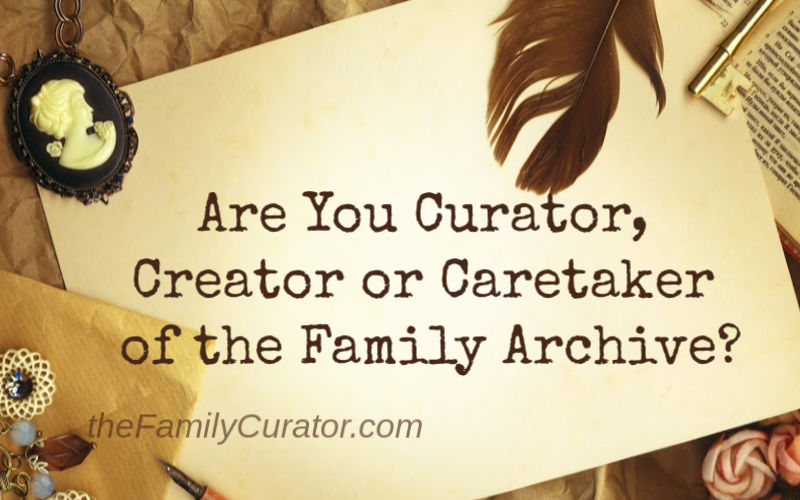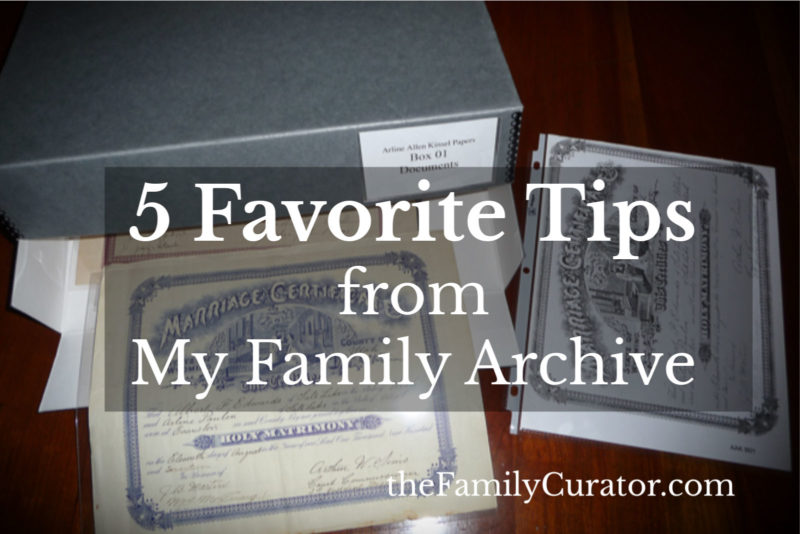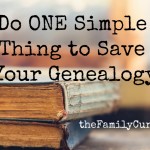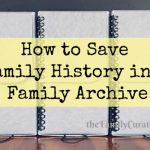
Did you inherit a family history archive? Do relatives send you shoeboxes stuffed with old photos and bins of genealogy research and pedigree charts? Are you wondering what to do with all that stuff, and if you have to take care of it forever?
Not at all. It’s your choice whether to be Curator, Creator, or Caretaker — or maybe a some of each.
Genealogists don’t have to downsize family heirlooms like a sock drawer to be in control of a family history archive.
You might even want to be a Curator today while planning to pass on the torch to a new Caretaker in the future.
I felt a tremendous sense of responsibility when I inherited my grandmother’s trunk of old photos, papers and keepsakes. I wondered if I would be derelict in my duty if I didn’t organize, preserve, and scan everything? Would I be letting down my grandmother? My great-grandmother? Did I have to save all those teacups?
Burden or Blessing?
The curatorial responsibility of a family archive could become a burden, but it doesn’t need to be. Our ancestors were only human, after all, like us. Their letters survived in cardboard boxes, wooden crates, and flimsy suitcases. Anything we do to preserve them is an improvement. It’s not hard to find “5 Things You Can Do Right Now to Save Your Family Heirlooms.” And, if all we do is donate them to a suitable public archive, we have done a good job.
When I first wrote about working with family photos, documents, and artifacts for The Family Curator Blog and for my book How to Archive Family Keepsakes, I wanted to share professional archival techniques with the non-professional family historian. I wanted to show that anyone could preserve family heirlooms with minimal fuss and expense. And, that getting it done is more important than getting it perfect. If we aimed for done, not perfect, we could stop feeling guilty about taking months (or years) to sort and move those photos out of the shoebox or choosing the best photos to digitize and print for our relatives.
Most professional archivists are not emotionally attached to the material they work with day after day. That’s an advantage. I get sidetracked remembering stories about people in the letters and photos. A new relative often sends me chasing names instead of sorting papers.
But when I can focus on the role, on the task at hand, I make good archival progress and learn so much about my ancestors from the things they left behind.
The Curator
I’ve always seen the role of Curator as my goal. A curator has to be the proverbial jack-of-all-trades. She has to understand why something is worth being saved and how best to preserve it. She also needs to come up with interesting ways to share the object and its story with others. A Curator sees the possibilities for these materials, but knows they need order and control. To my mind, a curator is an appraiser, an archivist, and an artist.
The Creator
The Creator sees possibility too. Writers, photographers, film makers, scrapbookers, and family historians are all creators who see potential projects in the depths of a family archive. It’s hard for Creator types to pause and organize, and then to pause again to preserve the materials they have used.
Curator or Creator, our job involves understanding how to be a Caretaker as well so we can leave our archive in better condition than we found it.
The Caretaker
The Caretaker may have taken on his job willingly or reluctantly, but his primary goal is to be a good steward of his ancestor’s estate. It’s a tough job, and hats off to all those Caretakers who preserved the old letters, documents, and photos that we cherish today.
In today’s world of minimalism, downsizing, and tiny houses, the Caretaker of a family archive may be more focused on donation than preservation. Finding a good fit for a family collection can be time-consuming. The benefits for future researchers, however, are tremendous.
It’s not hard to imagine the not-so-distant future when handwritten letters, household receipts, and snapshots are as rare as the dodo. Historians with access to the ephemera of daily family life will be able to learn much and write about our society. Those artifacts may be more accessible in public archives than in private collections.
What’s Your Role, and Goal?
Curator, Creator, or Caretaker — identifying your role and goal as the family archivist, with the time and resources available to you today, can help you work with your archive without feeling overwhelmed or burdened with guilt.
A good action plan will evolve as new information is discovered or personal circumstances change. Many genealogists have inherited boxes of photos and papers, along with a self-inflicted obligation to digitize every single photo or sheet of paper. Why? Is that reasonable and necessary? Or would it be more practical to organize and preserve the materials in archival storage and scan only selected items?
The future of a family archive depends on finding practical, do-able solutions, realigning goals and objectives as we become more knowledgeable and more comfortable as Family Curator, Creator or Caretaker. The job title doesn’t define who we are but it does help identify what we want to accomplish and how we can get there. Hopefully, we will become better family historians and closer to our ancestors on the journey.
Read more about Family Archiving in How to Archive Family Keepsakes: Learn How to Preserve Family Photos, Memorabilia & Genealogy Records by Denise May Levenick.
Disclosure: This website uses affiliate links. Read more on our Disclosure Page.






I have macular degeneration. And I find it hard ti read your written articles because they appear light grey to me. Black print would be easier to read for vision impaired. BettyHamilton